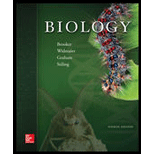
Concept explainers
Introduction: The general term ‘salt’ is used to refer to a compound formed by an attraction between a positively charged ion, such as sodium (
Answer to Problem 1TY
Correct answer: A change in the ion (salt) concentration in an animal’s body may result in altered membrane potentials. This disrupts normal cell function, certain biochemical processes that occur in the cell, and movement of water between fluid compartments. Hence, the correct answer is option e.
Explanation of Solution
Reason for correct answer:
The cell is said to be polarized at its resting state. The inside of the cell is negatively charged and it contains a high concentration of chloride ions. The outside of the cell is positively charged and it contains a high concentration of sodium ions. The changes in the concentration of ions from dissolved salts in the extracellular and intracellular fluids disturb the homeostasis and various important functions.
Option e. is given as “a, b, and c”.
The altered concentration of ions disturbs the membrane potential, biochemical processes, and flow of water. Hence, the correct answer is option (e).
Reasons for incorrect answer:
Option a. is given as, “altered membrane potentials that disrupt normal cell function”.
The change in the salt concentration in an animal’s body causes alteration in the membrane potential. This disrupts the normal cell function, for example, electrical potential across the plasma membrane in the cells of the heart and brain. However, it also disturbs the biochemical processes occurring in the cell and the water flow. Hence, option a. is incorrect.
Option b. is given as, “disruption of certain biochemical processes that occur in the cell”.
The change in the animal’s body ion concentration alters the biochemical process, for example, muscle contraction occurring in the cell. However, it also alters the membrane potential and movement of water. Hence, option b. is incorrect.
Option c. is given as, “movement of water between fluid compartments”.
The alteration in the ion concentration is also related to causing disturbance in the movement of water across the membrane. However, it also results in causing disturbance in membrane potential and certain biochemical processes. Hence, option c. is incorrect.
Option d. is given as, “a and b only”.
The alteration in the ion concentration in an animal’s body result in causing disturbance in the membrane potential, biochemical processes occurring in the cell, and movement of water between fluid compartments. Hence, option d. is incorrect.
Hence, the options a., b., c., and d. are incorrect.
The change in the ion (salt) concentration in an animal’s body may result in altered membrane potentials that disrupt the normal cell function, certain biochemical processes occurring in the cell, and movement of water between fluid compartments.
Want to see more full solutions like this?
Chapter 49 Solutions
Biology
- Give examples of fat soluble and non-fat soluble hormonesarrow_forwardJust click view full document and register so you can see the whole document. how do i access this. following from the previous question; https://www.bartleby.com/questions-and-answers/hi-hi-with-this-unit-assessment-psy4406-tp4-report-assessment-material-case-stydu-ms-alecia-moore.-o/5e09906a-5101-4297-a8f7-49449b0bb5a7. on Google this image comes up and i have signed/ payed for the service and unable to access the full document. are you able to copy and past to this response. please see the screenshot from google page. unfortunality its not allowing me attch the image can you please show me the mathmetic calculation/ workout for the reult sectionarrow_forwardIn tabular form, differentiate between reversible and irreversible cell injury.arrow_forward
- 1.)What cross will result in half homozygous dominant offspring and half heterozygous offspring? 2.) What cross will result in all heterozygous offspring?arrow_forward1.Steroids like testosterone and estrogen are nonpolar and large (~18 carbons). Steroids diffuse through membranes without transporters. Compare and contrast the remaining substances and circle the three substances that can diffuse through a membrane the fastest, without a transporter. Put a square around the other substance that can also diffuse through a membrane (1000x slower but also without a transporter). Molecule Steroid H+ CO₂ Glucose (C6H12O6) H₂O Na+ N₂ Size (Small/Big) Big Nonpolar/Polar/ Nonpolar lonizedarrow_forwardwhat are the answer from the bookarrow_forward
- what is lung cancer why plants removes liquid water intead water vapoursarrow_forward*Example 2: Tracing the path of an autosomal dominant trait Trait: Neurofibromatosis Forms of the trait: The dominant form is neurofibromatosis, caused by the production of an abnormal form of the protein neurofibromin. Affected individuals show spots of abnormal skin pigmentation and non-cancerous tumors that can interfere with the nervous system and cause blindness. Some tumors can convert to a cancerous form. i The recessive form is a normal protein - in other words, no neurofibromatosis.moovi A typical pedigree for a family that carries neurofibromatosis is shown below. Note that carriers are not indicated with half-colored shapes in this chart. Use the letter "N" to indicate the dominant neurofibromatosis allele, and the letter "n" for the normal allele. Nn nn nn 2 nn Nn A 3 N-arrow_forwardI want to be a super nutrition guy what u guys like recommend mearrow_forward
 Human Anatomy & Physiology (11th Edition)BiologyISBN:9780134580999Author:Elaine N. Marieb, Katja N. HoehnPublisher:PEARSON
Human Anatomy & Physiology (11th Edition)BiologyISBN:9780134580999Author:Elaine N. Marieb, Katja N. HoehnPublisher:PEARSON Biology 2eBiologyISBN:9781947172517Author:Matthew Douglas, Jung Choi, Mary Ann ClarkPublisher:OpenStax
Biology 2eBiologyISBN:9781947172517Author:Matthew Douglas, Jung Choi, Mary Ann ClarkPublisher:OpenStax Anatomy & PhysiologyBiologyISBN:9781259398629Author:McKinley, Michael P., O'loughlin, Valerie Dean, Bidle, Theresa StouterPublisher:Mcgraw Hill Education,
Anatomy & PhysiologyBiologyISBN:9781259398629Author:McKinley, Michael P., O'loughlin, Valerie Dean, Bidle, Theresa StouterPublisher:Mcgraw Hill Education, Molecular Biology of the Cell (Sixth Edition)BiologyISBN:9780815344322Author:Bruce Alberts, Alexander D. Johnson, Julian Lewis, David Morgan, Martin Raff, Keith Roberts, Peter WalterPublisher:W. W. Norton & Company
Molecular Biology of the Cell (Sixth Edition)BiologyISBN:9780815344322Author:Bruce Alberts, Alexander D. Johnson, Julian Lewis, David Morgan, Martin Raff, Keith Roberts, Peter WalterPublisher:W. W. Norton & Company Laboratory Manual For Human Anatomy & PhysiologyBiologyISBN:9781260159363Author:Martin, Terry R., Prentice-craver, CynthiaPublisher:McGraw-Hill Publishing Co.
Laboratory Manual For Human Anatomy & PhysiologyBiologyISBN:9781260159363Author:Martin, Terry R., Prentice-craver, CynthiaPublisher:McGraw-Hill Publishing Co. Inquiry Into Life (16th Edition)BiologyISBN:9781260231700Author:Sylvia S. Mader, Michael WindelspechtPublisher:McGraw Hill Education
Inquiry Into Life (16th Edition)BiologyISBN:9781260231700Author:Sylvia S. Mader, Michael WindelspechtPublisher:McGraw Hill Education





